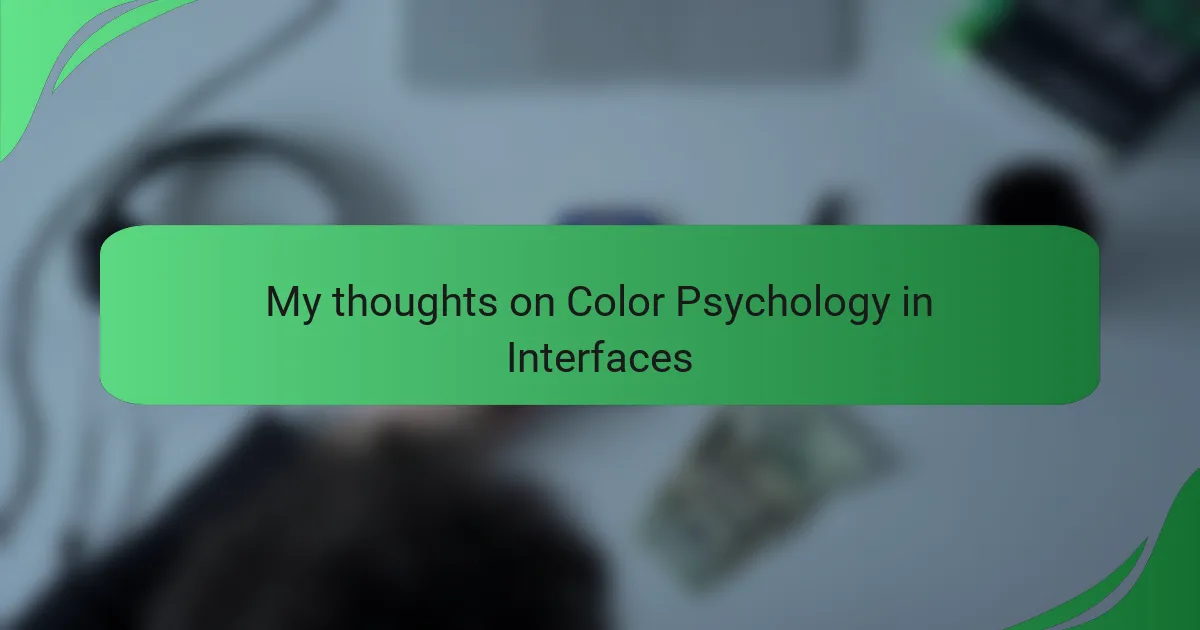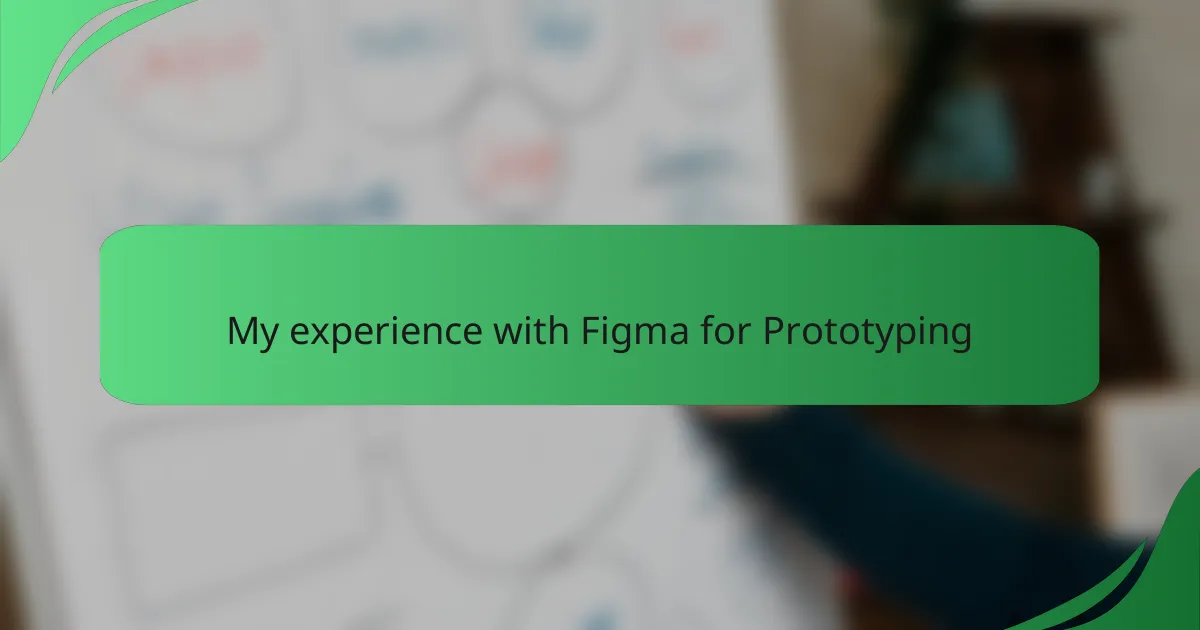Key takeaways
- Color psychology significantly influences human emotions and behaviors, impacting user engagement in interface design.
- Warm colors like red and orange can evoke urgency, while cool colors like blue and green foster trust and calmness.
- Consistency in color palettes enhances brand identity and user recognition, leading to a more effective design.
- Accessibility is crucial in color selection; high-contrast colors improve usability for all users.
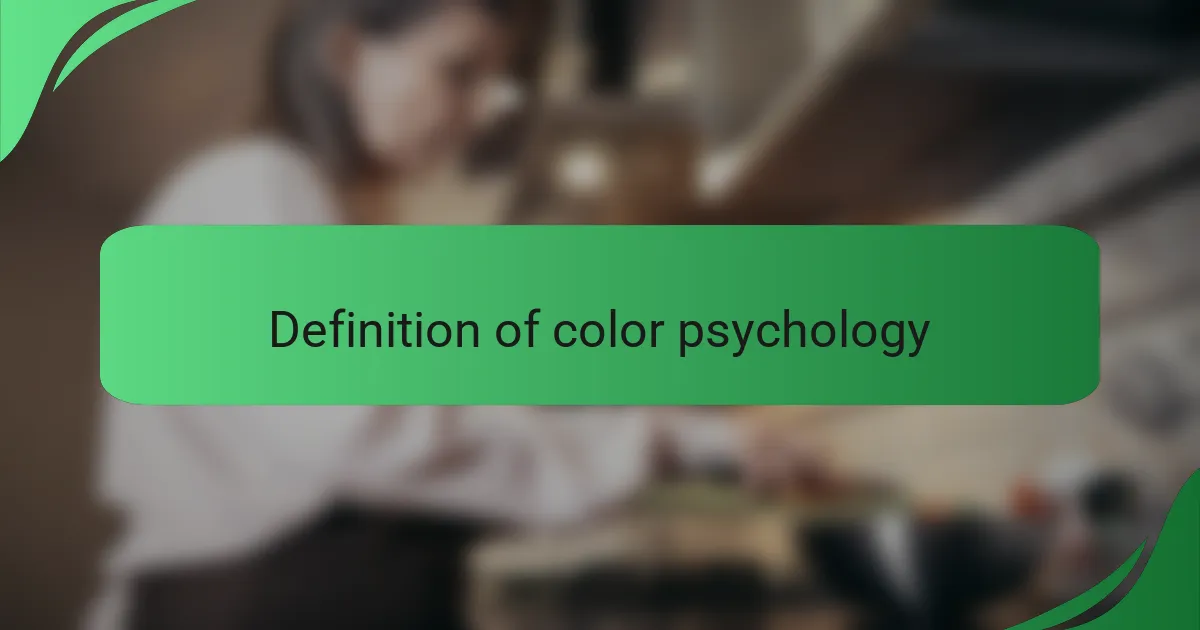
Definition of color psychology
Color psychology is the study of how colors affect human emotions, perceptions, and behaviors. It’s fascinating to think about how something as simple as a color can influence our feelings and decisions. For instance, have you ever noticed how red can evoke excitement while blue often instills calmness?
In my experience, the colors we choose in interface design can make a significant impact on user interaction. When I’ve used warm colors in a project, I’ve seen users engage more energetically. It’s almost as if the colors breathe life into the design.
Understanding color psychology isn’t just an abstract concept; it’s rooted in our daily experiences. When I walk into a space painted in soft greens, I can’t help but feel at ease. It’s clear that the emotions triggered by color play an essential role in creating effective interfaces that resonate with users on a deeper level.
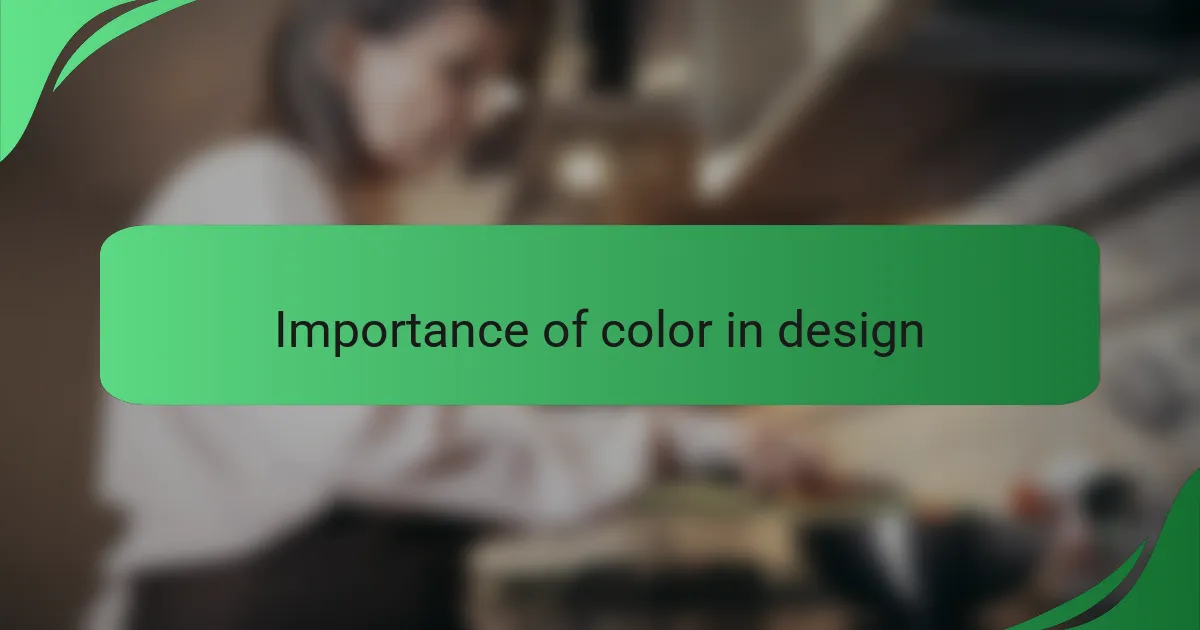
Importance of color in design
When it comes to interface design, color serves as a powerful tool in conveying emotions and guiding user behavior. I’ve noticed in my own experience that certain colors can evoke immediate reactions; for example, the warmth of red often captures attention, while blue tends to create a sense of trust and calm. This psychological impact is not just theory—I’ve seen it firsthand in user testing, where a simple color adjustment can significantly improve user engagement.
The importance of color also plays into branding and recognition. A consistent color palette can enhance familiarity, making interfaces memorable. I remember working on a project where we chose a specific shade of green; it not only aligned with the brand’s identity but also fostered a feeling of relaxation for users, which was crucial for the application’s purpose.
Here’s a comparison of how different colors can affect user perceptions:
| Color | Psychological Effect |
|---|---|
| Red | Excitement, urgency |
| Blue | Trust, calmness |
| Green | Harmony, relaxation |
| Yellow | Optimism, attention-grabbing |
| Purple | Luxury, creativity |
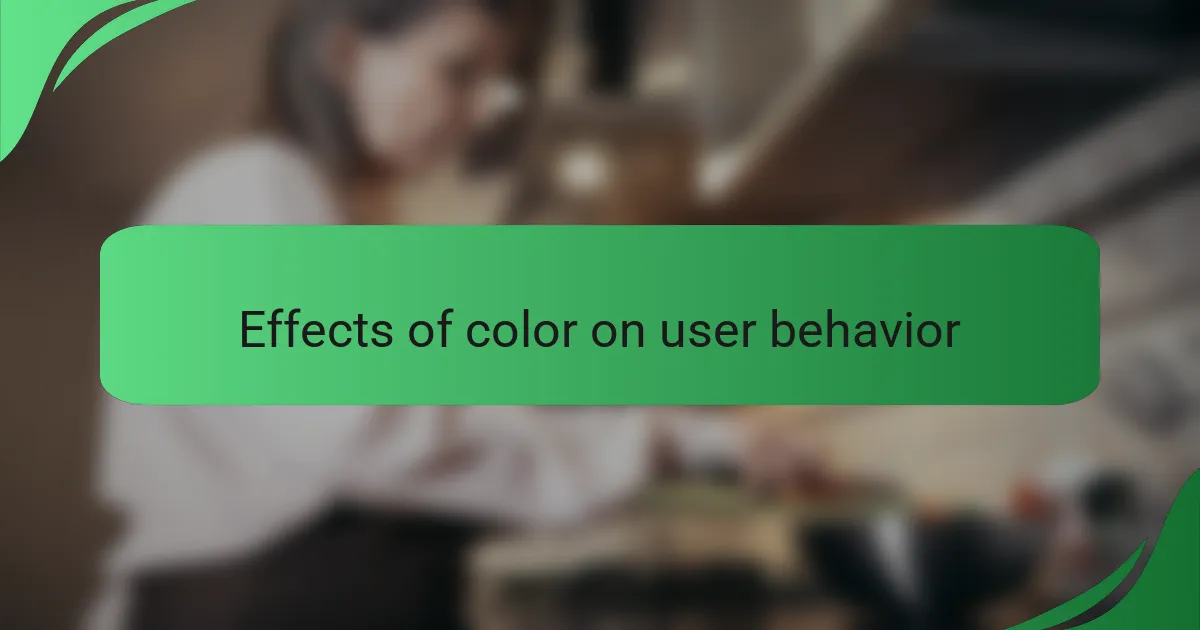
Effects of color on user behavior
Color plays a pivotal role in how users interact with interfaces. I’ve observed firsthand that warm colors like red and orange can evoke urgency, compelling users to take action quickly. Conversely, cooler shades like blue often foster a sense of trust and calm, making them ideal for financial or health-related applications.
In my experience, the emotional response to color can significantly alter user behavior. While working on a project with a client in the wellness industry, we shifted the primary color scheme from gray to green. The results were immediate—user engagement heightened, and feedback grew more positive. It’s fascinating how such a simple change can lead to a strong emotional impact.
- Warm colors (red, orange) can increase urgency and prompt quick actions.
- Cool colors (blue, green) enhance feelings of trust and calm.
- Color contrasts can emphasize important features and encourage exploration.
- Preferences for color can vary culturally, making it crucial to know your target audience.
- Personal experiences with color can affect user interactions, making them feel more connected.
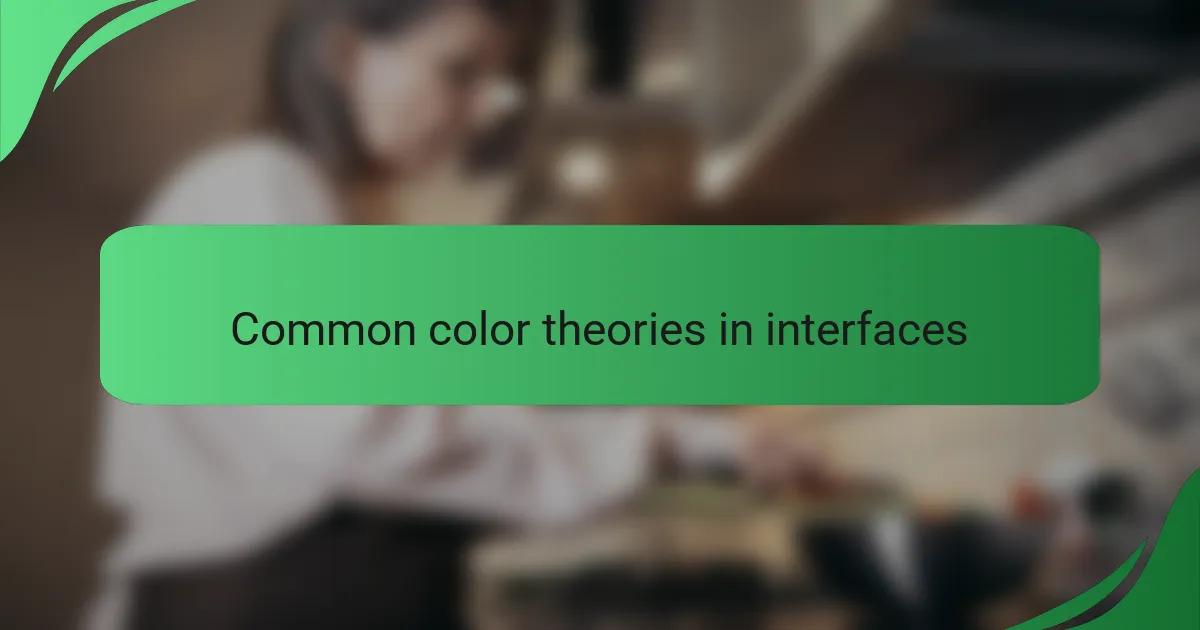
Common color theories in interfaces
When it comes to color theory in interfaces, I’ve always found that understanding basic color relationships can dramatically influence user experience. For instance, complementary colors are fascinating because they create contrast that catches the eye. I remember designing a landing page where I used blue and orange; it really drew in users and kept them engaged.
Another intriguing aspect is the psychological impact of color temperature. Warm tones often evoke feelings of comfort and positivity, while cool colors can convey serenity and professionalism. During a project, I opted for a warm color palette for a wellness app, and the feedback was overwhelmingly positive, with users commenting that it felt inviting and reassuring.
- Primary Colors: Red, blue, and yellow; foundational colors that form the basis of other hues.
- Complementary Colors: Opposite colors on the color wheel that highlight each other (e.g., blue and orange).
- Analogous Colors: Colors next to each other on the wheel that create harmony (like green, teal, and blue).
- Warm Colors: Reds, oranges, and yellows that elicit energy and warmth.
- Cool Colors: Blues, greens, and purples that promote calmness and relaxation.
These principles are not just theoretical; they can shape how users interact with a design in real-world scenarios.

Best practices for color selection
Choosing colors for an interface goes beyond mere aesthetics; it hinges on understanding user emotions and reactions. When I select colors, I often ask myself how they align with the intended message of the design. For example, during a recent project, I chose a calm blue palette because the goal was to foster trust in users—much like the serene feeling I experience when I see a clear blue sky.
It’s essential to consider accessibility alongside your color choices. I remember a time when I overlooked color contrast, which led some users to struggle with readability. This experience taught me that clear contrast not only enhances the overall user experience but also ensures that everyone, regardless of visual ability, can engage with the interface. I now prioritize high-contrast color pairs to promote clarity and usability.
Lastly, sticking to a cohesive color palette can enhance user recognition and brand identity. I’ve found that limiting myself to three primary colors allows for a more focused design. It helps create a harmonious look while evoking the desired emotions—similar to how a well-curated collection of books on a shelf draws the eye and invites exploration. What colors connect with your audience? Exploring that question can guide you toward your ideal color selections.
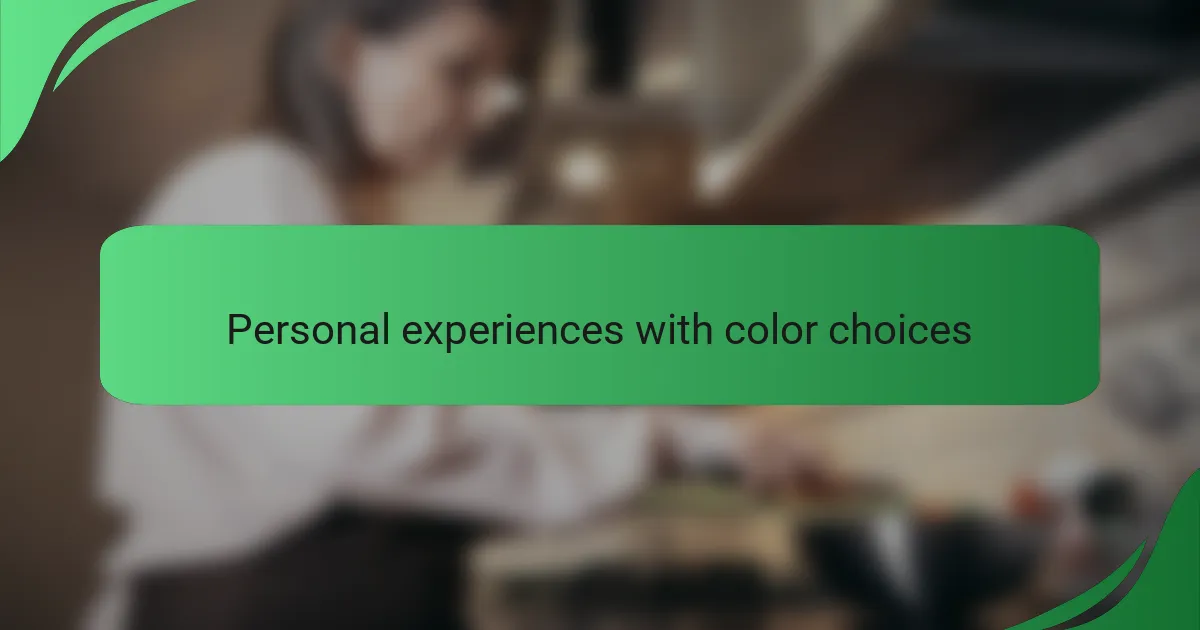
Personal experiences with color choices
The decisions I make regarding color choices often stem from emotional connections I have with certain hues. For example, when I designed an app aimed at promoting mindfulness, I instinctively gravitated toward soft greens and earthy tones. Each time I opened that project, I felt a surge of calmness, almost as if the colors themselves whispered tranquility. Isn’t it fascinating how color can evoke such strong feelings?
There was a time when I experimented with bold colors for a marketing campaign. I opted for a vibrant orange, thinking it would inject energy and excitement into the interface. However, the feedback was mixed; while some users found it lively, others felt overwhelmed. This taught me a crucial lesson: color perception is incredibly subjective and relies significantly on the context in which it’s used. Have you ever noticed how colors can resonate differently with various audiences?
Reflecting on my journey with color selections, I’ve come to appreciate the power of simplicity. In one particular project, I decided to limit the palette to just three main colors, and the results were stunning. The interface felt cohesive and inviting, leading to improved user engagement. It’s amazing how a few well-chosen colors can create a welcoming space—almost like inviting someone into your home with a consistent theme that feels both warm and familiar.
